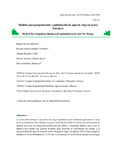
Please use this identifier to cite or link to this item:
http://ricaxcan.uaz.edu.mx/jspui/handle/20.500.11845/852Full metadata record
| DC Field | Value | Language |
|---|---|---|
| dc.contributor | 253184 | es_ES |
| dc.coverage.spatial | México | es_ES |
| dc.creator | Servin Palestina, Miguel | - |
| dc.creator | Sánchez Gutiérrez, Ricardo Alonso | - |
| dc.creator | Ramírez Valle, Orlando | - |
| dc.creator | Galindo Reyes, Manuel Antonio | - |
| dc.creator | Gutiérrez Bañuelos, Héctor | - |
| dc.date.accessioned | 2019-03-25T19:32:46Z | - |
| dc.date.available | 2019-03-25T19:32:46Z | - |
| dc.date.issued | 2018-10 | - |
| dc.identifier | info:eu-repo/semantics/publishedVersion | es_ES |
| dc.identifier.issn | 2448-6698 | es_ES |
| dc.identifier.uri | http://localhost/xmlui/handle/20.500.11845/852 | - |
| dc.description | Irrigated oats is an important forage-crop for livestock industry in arid and semi-arid zones; however, there is a lack of information regarding the relationship of dry matter yield and crop actual evapotranspiration or water demand; then the objective of the study was to develop mathematical models to describe yield and water use efficiency at different levels of irrigation water added. Maximum (P<0.05) yield (12.78 t ha-1) was found when 610.13 mm of water was applied, highest (P<0.05) water use efficiency was 2.36 kg of forage m-3 with 463.64 mm water applied and yielded 11.22 t ha-1, harvesting at the milky-dough stage (155 d after sowing or 1,291.5 degree days). Crop characteristics and mean effect of the soil evaporation (Kc), in function of the degree days, were better described by a cubic model. Using these models, in addition with the potential evapotranspiration, it is possible to estimate daily water demand, and it can be concluded that 7.15 mm d-1 is the maximum demand while 5.8 mm d-1 is the optimal demand without compromising yield. These models are a useful tool to optimize forage production from irrigated oats based on time and amount of water to be applied. | es_ES |
| dc.description.abstract | La avena como forraje es un cultivo de riego importante para la industria pecuaria en zonas áridas y semiáridas. Sin embargo, hay poca información sobre la relación del rendimiento de materia seca con la evapotranspiración real del cultivo o demanda hídrica, por lo que el objetivo del estudio fue generar modelos para describir el rendimiento de forraje y la productividad del agua al variar el aporte de agua de riego. Al aplicar 610.13 mm se logró el máximo (P<0.05) rendimiento (12.78 t ha-1) y la máxima (P<0.05) eficiencia del uso del agua (2.36 kg de forraje m-3) fue al aplicar 463.64 mm y con rendimiento de 11.22 t ha-1, cosechando a grano lechoso-masoso (155 días después de la siembra o 1,291.5 grados días de desarrollo). El modelo cúbico ajustó mejor las características del cultivo y los efectos promedios de la evaporación del suelo (Kc) en función de los grados días de desarrollo. Con dichos modelos y la evapotranspiración potencial, es posible representar la demanda hídrica diaria del cultivo con un modelo matemático y concluir, que la demanda máxima es de 7.15 mm dia-1 y la demanda óptima sin poner en riesgo el rendimiento es de 5.8 mm dia-1. Estos modelos constituyen una herramienta útil para optimizar la producción de forraje con avena de riego con base en la aplicación oportuna y cantidad adecuada de agua de riego. | es_ES |
| dc.language.iso | spa | es_ES |
| dc.publisher | Instituto Nacional de Investigaciones Forestales, Agrícolas y Pecuarias | es_ES |
| dc.relation | https://cienciaspecuarias.inifap.gob.mx/index.php/Pecuarias/article/view/4404/3942 | es_ES |
| dc.relation.ispartof | https://cienciaspecuarias.inifap.gob.mx/index.php/Pecuarias/article/view/4404 | es_ES |
| dc.relation.uri | generalPublic | es_ES |
| dc.rights | Atribución-NoComercial-CompartirIgual 3.0 Estados Unidos de América | * |
| dc.rights.uri | http://creativecommons.org/licenses/by-nc-sa/3.0/us/ | * |
| dc.source | Revista Mexicana de Ciencias Pecuarias, Vol. 9, No. 4, 2018, pp 667-684. | es_ES |
| dc.subject.classification | CIENCIAS AGROPECUARIAS Y BIOTECNOLOGIA [6] | es_ES |
| dc.subject.other | Planeación agrícola | es_ES |
| dc.subject.other | Productividad del agua | es_ES |
| dc.subject.other | Funciones de respuesta | es_ES |
| dc.subject.other | Grados días de desarrollo | es_ES |
| dc.subject.other | Uso consuntivo | es_ES |
| dc.title | Modelos para programación y optimización de agua de riego en avena forrajera | es_ES |
| dc.title.alternative | Models for irrigation timing and optimization in oats for forage | es_ES |
| dc.type | info:eu-repo/semantics/article | es_ES |
| Appears in Collections: | *Documentos Académicos*-- UA Veterinaría | |
Files in This Item:
| File | Description | Size | Format | |
|---|---|---|---|---|
| Servin Palestina et al., 2018. Riego de avena.pdf | 740,91 kB | Adobe PDF |  View/Open |
This item is licensed under a Creative Commons License
